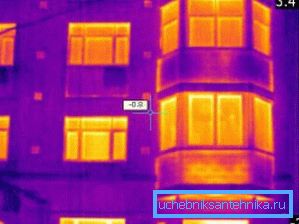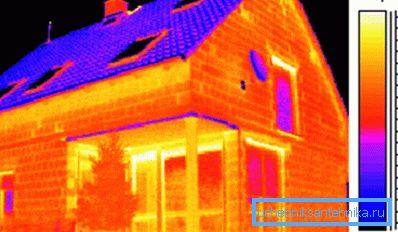Specific heating characteristic of the building - what it is
The specific heating characteristic of the building is a very important technical parameter. Its calculation is necessary to perform design and construction work, in addition, knowledge of this parameter does not interfere with the consumer, since it affects the amount of payment for thermal energy. Below we consider what is the specific heating characteristic and how it is calculated.

The concept of specific thermal characteristics
Before getting acquainted with the calculations, we define the basic terms. So, the specific thermal characteristic of a building for heating is the value of the greatest heat flux, which is necessary for heating a house. When calculating this parameter, the temperature delta, i.e. the difference between room temperature and outdoor temperature, it is customary to take for one degree.
In fact, this indicator determines the energy efficiency of the building.
Average parameters are determined by regulatory documentation, such as:
- Construction rules and recommendations;
- SNiPs, etc.
Any deviation from the indicated norms in any direction allows to get an idea about the energy efficiency of the heating system. The calculation of the parameter is carried out according to SNiP and other current methods.

Calculation method
Thermal specific characteristics of buildings can be:
- Actual - for obtaining accurate indicators, a thermal imaging inspection of the structure is used.
- Settlement regulatory - is determined using tables and formulas.
Below we take a closer look at the features of the calculation of each type.
Tip! To obtain the thermal characteristics of the house you can contact the experts. True, the price of such calculations can be substantial, therefore it is more expedient to carry them out independently.

Settlement and standard indicators
Estimated figures can be obtained by the following formula:
qhere= + + None* + N2), where:
| qhere ,W / (m3oWITH) | The amount of heat lost by one meter cubic building with a temperature difference of 1 degree. |
| F0, m2 | Heated area of the building |
| Fst., FOK., Ffloor., Fpok, m2 | The area of the walls (exterior), windows, floor, cover. |
| Rst., ROK., Rfloor., Rpok, | Resistance to heat transfer surfaces. |
| n | The coefficient that varies depending on the location of the room relative to the street. |
I must say that this formula is not the only one. Specific heating characteristics of buildings can be determined by local building codes, as well as by certain methods of self-regulating organizations, etc.


The calculation of the actual thermal characteristics is carried out according to the following formula
In this formula, the basis consists of the actual parameters:
| Q | Fuel consumption during the year |
| Z | Duration of the heating season |
| tint | Average room temperature |
| text | Average outside temperature |
| qfact | The actual specific heating characteristics of the building |
It should be noted that this equation is simple, as a result of which it is often used in calculations. However, it has a serious drawback, which affects the accuracy of the obtained calculations. Namely - takes into account the temperature difference in the premises of the building.
To get your own hands more accurate data, you can apply the calculations with the definition of heat consumption by:
- Indicators of heat loss through various building structures;
- Project documentation.
- Integrated indicators.

Self-regulatory organizations usually use their own methods.
They take into account the following parameters:
- Architectural and planning data;
- Year of construction of the house;
- Street air temperature correction factors during the heating season.
In addition, the actual specific heating characteristic of residential buildings should be determined taking into account the heat loss in pipelines passing through the "cold" rooms, as well as the cost of air conditioning ventilation. These coefficients can be found in special tables of SNiP.
Here, perhaps, is the whole basic instruction for determining the specific thermal parameter.
Energy efficiency class
Specific heat characteristic serves as the basis for obtaining such an indicator as the energy efficiency class at home. In recent years, the energy efficiency class should be mandatory for residential apartment buildings.

The definition of this parameter is based on the following data:
- Deviation of actual indicators and settlement and regulatory data. Moreover, the first can be obtained both in a calculated and practical way, i.e. using thermal imaging.
- Climatic features of the area.
- Regulatory data, which should include information on the costs of heating, as well as ventilation and air conditioning.
- Type of building.
- Technical characteristics of used building materials.
Each class has certain values of energy consumption throughout the year. Energy efficiency class should be noted in the energy passport of the house.
Conclusion
The specific heating characteristic of buildings is an important parameter, which depends on a number of factors. As we found out, you can define it yourself, which in the future will allow you to calculate the energy consumption for heating in the house.
From the video in this article, you can learn some additional information on this topic.